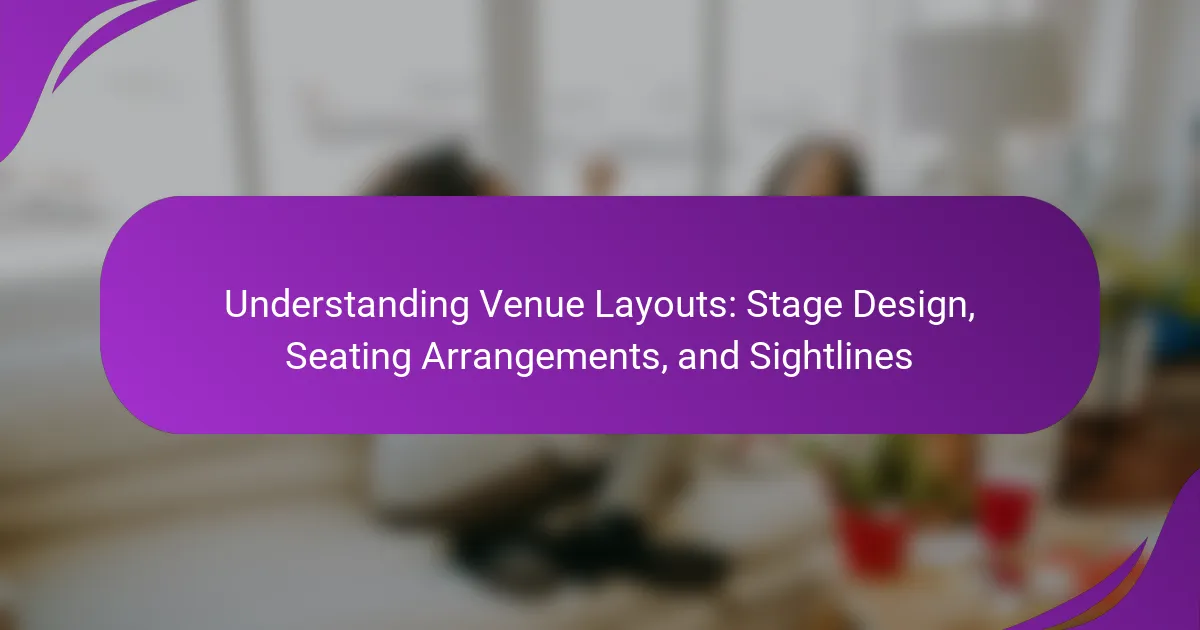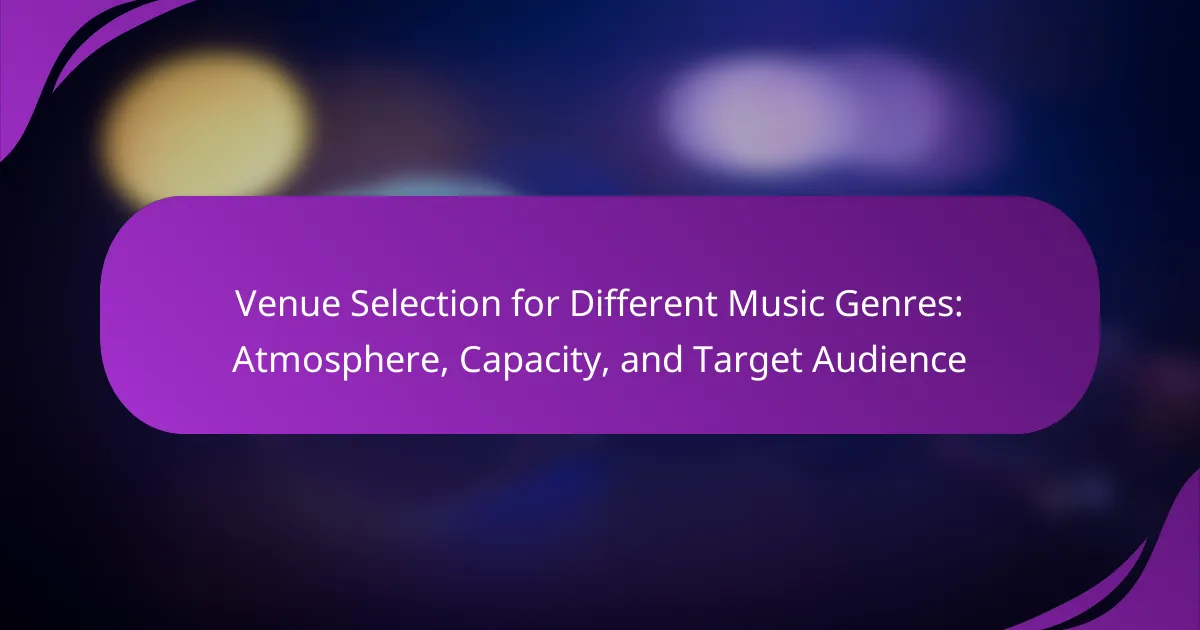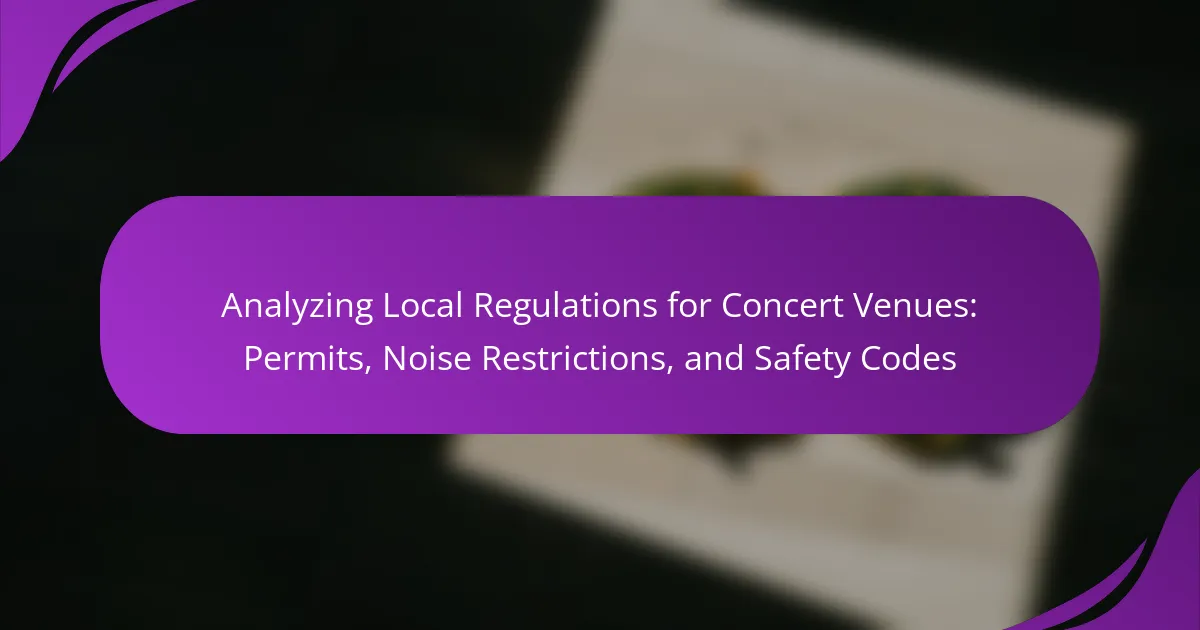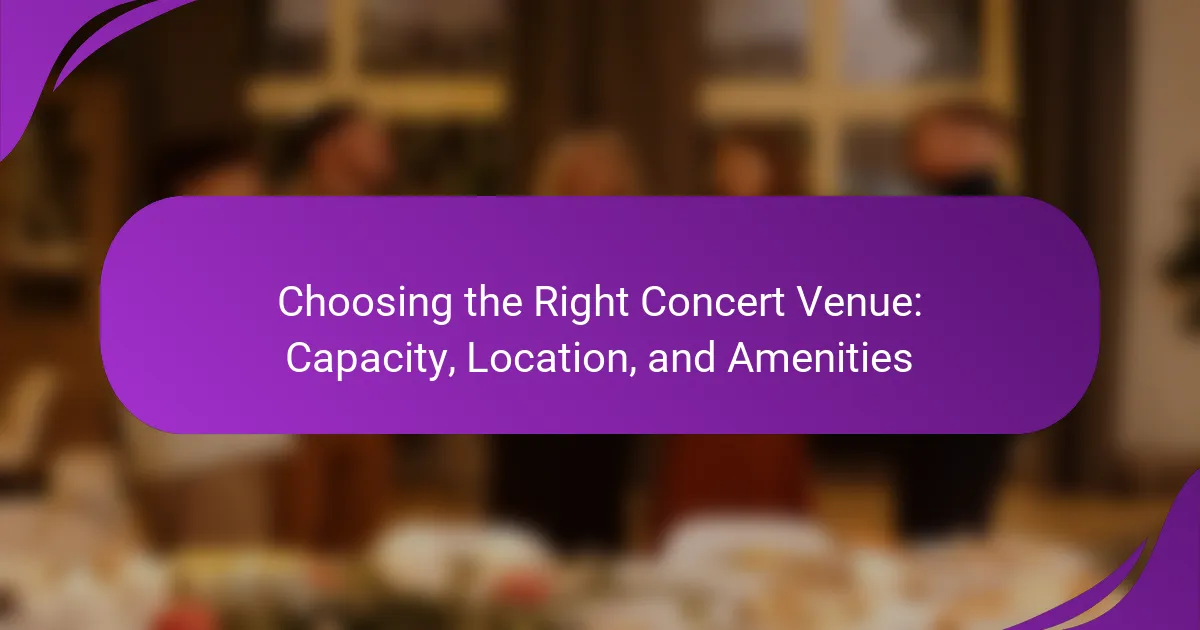Venue accessibility for concerts encompasses the design and features that allow individuals, including those with disabilities, to access and enjoy events. Key aspects include compliance with the Americans with Disabilities Act (ADA), which mandates accommodations such as accessible seating, parking, restrooms, and clear signage. Transportation options play a vital role in enhancing accessibility, with public transport availability and adequate parking facilities being essential for attendees. The article will cover the importance of designated parking spaces, the requirements for ADA compliance, and how these factors contribute to a more inclusive concert experience for all participants.
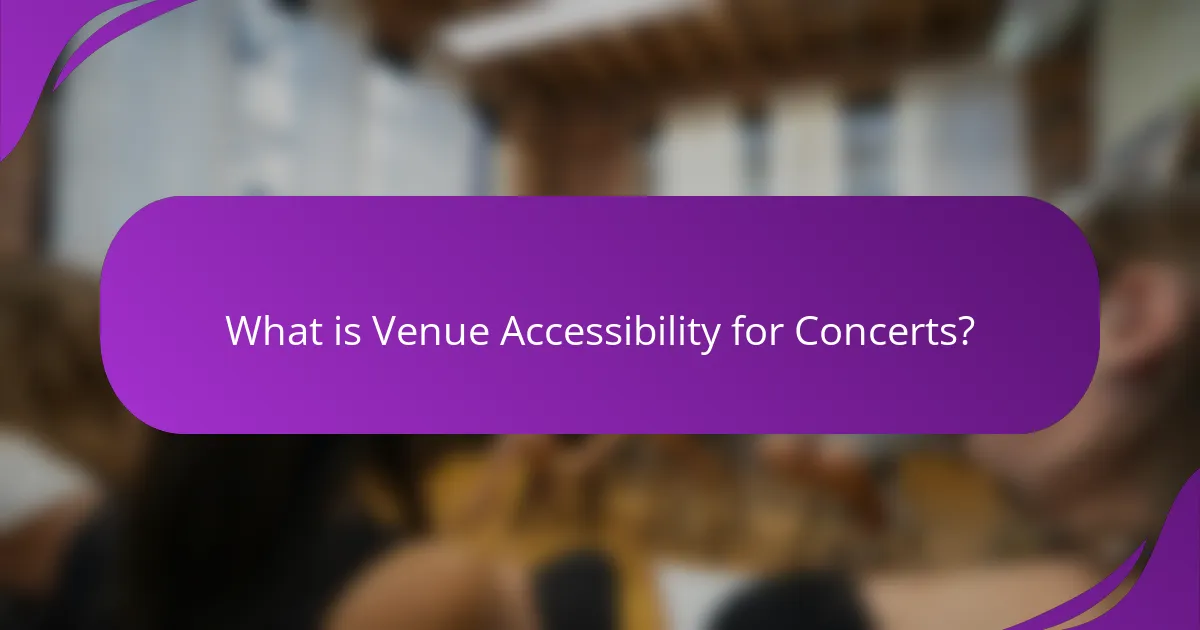
What is Venue Accessibility for Concerts?
Venue accessibility for concerts refers to the design and features of a venue that enable all individuals, including those with disabilities, to access and enjoy the event. This includes physical access to the venue, such as ramps and elevators, as well as accessible seating areas. Compliance with the Americans with Disabilities Act (ADA) is a critical factor in determining venue accessibility. ADA regulations require venues to provide accommodations like designated parking spaces, accessible restrooms, and proper signage. Ensuring venue accessibility enhances the experience for all concertgoers and promotes inclusivity.
How is venue accessibility defined in the context of concerts?
Venue accessibility in the context of concerts refers to the ease with which individuals, including those with disabilities, can enter, navigate, and enjoy the venue. This includes features such as ramps, elevators, designated seating, and accessible restrooms. Compliance with the Americans with Disabilities Act (ADA) is a key standard for defining venue accessibility. Venues must provide appropriate accommodations to ensure all attendees can participate fully. Statistics show that 1 in 4 adults in the U.S. has a disability, highlighting the importance of accessible venues. Additionally, accessibility impacts audience size and satisfaction, making it a critical aspect of concert planning.
What are the key components of venue accessibility?
The key components of venue accessibility include physical access, transportation options, and compliance with ADA standards. Physical access involves ramps, elevators, and designated seating for individuals with disabilities. Transportation options should include accessible public transit and parking spaces near the venue. Compliance with ADA standards ensures that venues meet legal requirements for accessibility. These components collectively enhance the experience for all attendees, promoting inclusivity at events.
Why is assessing venue accessibility important for concertgoers?
Assessing venue accessibility is crucial for concertgoers to ensure an inclusive experience. It allows individuals with disabilities to participate fully in events. Accessibility features may include ramps, designated seating, and accessible restrooms. According to the Americans with Disabilities Act (ADA), venues must accommodate individuals with disabilities. Failure to assess accessibility can lead to exclusion and negative experiences. Statistics show that 1 in 4 adults in the U.S. have a disability. Ensuring accessibility can increase attendance and enhance the overall concert experience for everyone.
What are the main factors to consider when assessing venue accessibility?
The main factors to consider when assessing venue accessibility include transportation options, parking facilities, and ADA compliance. Transportation options should accommodate various means of travel, including public transit and ride-sharing services. Parking facilities must provide accessible spaces close to the venue entrance. ADA compliance ensures that the venue meets legal requirements for accessibility, such as ramps, elevators, and restrooms. Additionally, clear signage and wayfinding are essential for guiding attendees with disabilities. Assessing these factors helps ensure an inclusive experience for all attendees.
How does transportation impact venue accessibility?
Transportation significantly impacts venue accessibility by determining how easily individuals can reach the location. Efficient public transport options, such as buses and trains, enhance access for attendees. Conversely, limited transportation options can hinder attendance, particularly for those without personal vehicles. The availability of accessible transport services is crucial for individuals with disabilities. A study by the National Center for Mobility Management found that improved transportation access increases event attendance by 30%. Therefore, effective transportation planning is essential for maximizing venue accessibility.
What role does parking play in ensuring accessibility for concert attendees?
Parking plays a crucial role in ensuring accessibility for concert attendees. Accessible parking spaces provide convenient access for individuals with disabilities. These designated spaces are typically located close to venue entrances. This proximity reduces the distance attendees must travel. Clear signage for accessible parking helps guide attendees to these spaces. Additionally, adequate parking capacity prevents overcrowding and delays. Compliance with the Americans with Disabilities Act (ADA) mandates accessible parking availability. Properly designed parking facilities enhance overall concert accessibility.
What is ADA compliance and why is it critical for concert venues?
ADA compliance refers to adherence to the Americans with Disabilities Act, which mandates accessibility for individuals with disabilities. It is critical for concert venues because it ensures equal access to facilities and services for all patrons. Compliance includes features such as wheelchair ramps, accessible seating, and proper signage. These accommodations help prevent discrimination and promote inclusivity. Non-compliance can lead to legal repercussions and financial penalties. Additionally, accessible venues can attract a broader audience, enhancing overall attendance and revenue. Ensuring ADA compliance also fosters a positive reputation for the venue within the community.
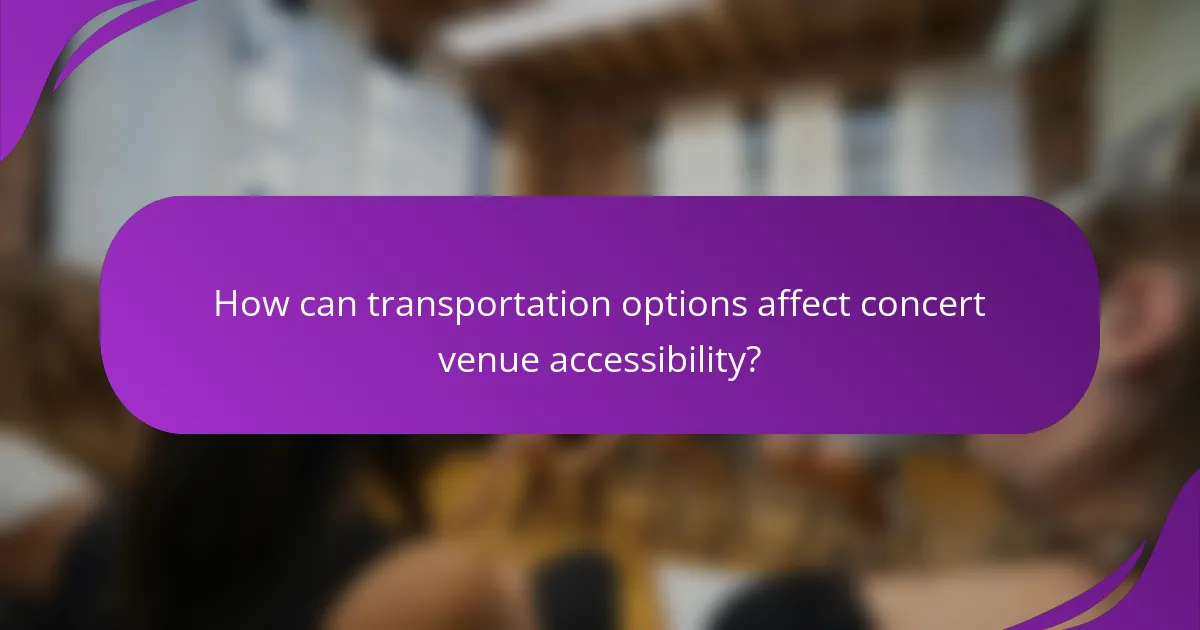
How can transportation options affect concert venue accessibility?
Transportation options significantly influence concert venue accessibility. Accessible transportation ensures that all attendees can reach the venue easily. Public transport availability, such as buses and trains, provides options for those without personal vehicles. The proximity of transport hubs to the venue can reduce travel time and effort. Adequate parking facilities, including accessible spots, enhance accessibility for those driving. Shuttle services can also bridge gaps between distant transport options and the venue. Additionally, real-time transport information can help attendees plan their journeys effectively. A study by the National Endowment for the Arts found that improved transportation options increase attendance at cultural events. Thus, diverse and efficient transportation options are crucial for enhancing concert venue accessibility.
What types of transportation should be evaluated for accessibility?
Public transportation, private vehicles, and rideshare services should be evaluated for accessibility. Public transportation includes buses, trains, and subways. These systems must have features like low floors and ramps. Private vehicles should be assessed for parking accessibility and drop-off zones. Rideshare services need to ensure accessible vehicle options. Each type of transportation impacts overall accessibility for concert attendees. Evaluating these options enhances the experience for individuals with disabilities.
How do public transportation options accommodate individuals with disabilities?
Public transportation options accommodate individuals with disabilities through various accessibility features. Buses and trains often have low floors for easy boarding. Many systems offer wheelchair ramps and designated seating areas. Audio and visual announcements assist those with hearing or vision impairments. Some transit agencies provide paratransit services for those unable to use standard options. In the United States, the Americans with Disabilities Act mandates these accommodations. Compliance with this law ensures public transit systems are accessible to all.
What are the considerations for rideshare services regarding accessibility?
Rideshare services must prioritize accessibility to accommodate individuals with disabilities. This includes providing vehicles that are wheelchair accessible. Services should ensure that drivers are trained to assist passengers with special needs. Clear communication about vehicle accessibility features is essential. Rideshare apps must include options for riders to indicate accessibility requirements. Compliance with the Americans with Disabilities Act (ADA) is a legal obligation for these services. Data shows that 20% of Americans have a disability, highlighting the need for inclusive transportation options.
How can transportation accessibility be improved for concert venues?
Transportation accessibility for concert venues can be improved by enhancing public transit options. Increasing the frequency of buses and trains during concert hours can facilitate easier access. Implementing shuttle services from key transit points directly to venues can also help. Providing clear signage for public transport routes to venues is essential for guidance. Ensuring that transport vehicles are accessible to individuals with disabilities is crucial. Collaborating with ride-sharing services to offer discounts for concert-goers can promote alternative transportation. Lastly, creating designated drop-off areas near venue entrances can improve accessibility for all attendees.
What strategies can venues implement to enhance transportation options?
Venues can enhance transportation options by partnering with local transit authorities. This collaboration can lead to increased public transport routes and schedules during events. Venues can also provide shuttle services from key locations. These shuttles can facilitate easier access for attendees. Additionally, implementing ride-sharing programs can offer convenient drop-off points. Venues can promote these options through their marketing channels. Providing clear signage for transportation options at the venue is also crucial. Studies show that improved access can increase attendance by up to 20%.
How can concert organizers collaborate with local transportation services?
Concert organizers can collaborate with local transportation services by establishing partnerships for shuttle services. This can enhance accessibility for concert attendees. They can coordinate schedules to align with concert times. Providing clear information about transportation options can improve attendee experience. Additionally, organizers can work with transportation services to create designated drop-off and pick-up zones. This helps manage traffic flow around the venue. Offering discounts or promotions for public transport can encourage its use. Utilizing social media and websites to communicate transportation details is also effective. These strategies ensure smooth transportation logistics for events.
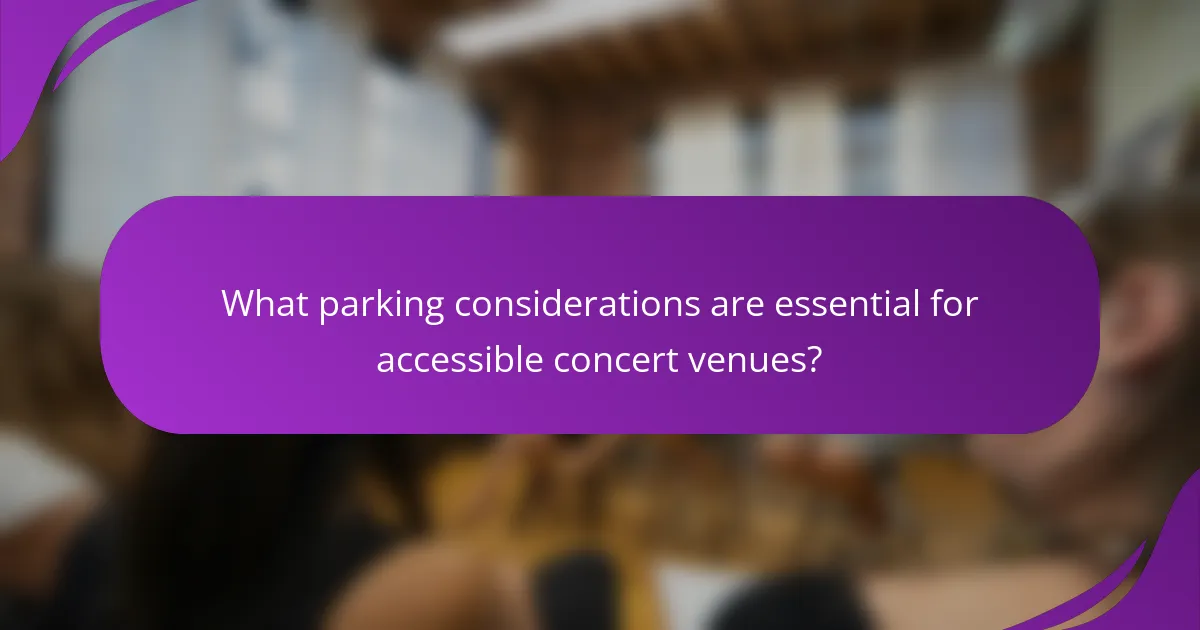
What parking considerations are essential for accessible concert venues?
Accessible concert venues must prioritize designated parking spaces for individuals with disabilities. These spaces should be located close to the venue entrance. The number of accessible spaces should comply with ADA guidelines, typically requiring at least one accessible space for every 25 total parking spaces. Each accessible space must be at least 8 feet wide, with an adjacent access aisle of at least 5 feet. Clear signage must indicate the designated accessible parking areas. The surface of accessible parking areas should be even and well-maintained to prevent hazards. Additionally, pathways from parking to the venue should be clear of obstacles and well-lit. These considerations enhance accessibility and ensure a positive experience for all attendees.
What are the specific requirements for accessible parking at concert venues?
Accessible parking at concert venues must comply with the Americans with Disabilities Act (ADA) regulations. This includes providing designated accessible parking spaces close to the venue entrance. The minimum number of accessible spaces required is based on the total number of parking spaces available. For example, venues with 1 to 25 spaces must have at least one accessible space.
Each accessible space must be at least 8 feet wide, with an adjacent access aisle of at least 5 feet wide. Signage must clearly mark these spaces as reserved for individuals with disabilities. Accessible parking should also be on a stable, firm surface to ensure safe access.
Moreover, the path from the accessible parking area to the venue must be free of obstacles and well-lit. These requirements ensure that individuals with disabilities can access concert venues safely and conveniently. Compliance with these standards is essential for promoting inclusivity at events.
How can venues ensure adequate accessible parking spaces?
Venues can ensure adequate accessible parking spaces by following specific guidelines. They should designate a sufficient number of accessible parking spots based on venue capacity. The Americans with Disabilities Act (ADA) recommends one accessible space for every 25 total parking spaces. Accessible parking spots must be located close to the venue entrance. They should be clearly marked with appropriate signage indicating accessibility. The parking spaces must be designed to accommodate various mobility devices, ensuring enough width for wheelchair access. Additionally, venues should regularly assess their parking facilities for compliance with ADA standards. This includes checking for proper maintenance and clear pathways to and from the parking areas. Regular audits can help identify any issues that need addressing.
What signage and communication strategies enhance parking accessibility?
Effective signage and communication strategies enhance parking accessibility by providing clear information and guidance. Clear directional signs help individuals locate accessible parking spaces. These signs should use universally recognized symbols, such as the wheelchair icon. Additionally, using large, legible fonts ensures visibility from a distance. Informational signs should include details about parking regulations and the location of accessible entrances. Digital communication, such as mobile apps, can provide real-time updates on parking availability. Regular maintenance of signage ensures that it remains visible and effective. Studies show that well-placed signage can significantly improve user experience and compliance with accessibility standards.
How can venues improve the parking experience for individuals with disabilities?
Venues can improve the parking experience for individuals with disabilities by ensuring accessible parking spaces are available. These spaces should be located close to entrances. They must be clearly marked and wider to accommodate mobility aids. Venues should also provide a sufficient number of accessible spots based on the total parking capacity. According to the ADA, there should be at least one accessible space for every 25 regular spaces. Additionally, venues can implement designated drop-off zones for individuals with disabilities. Providing clear signage and assistance from staff can enhance the experience further. Regular maintenance of parking areas ensures they remain safe and accessible.
What best practices should be followed for accessible parking management?
Accessible parking management should prioritize clear signage and designated spaces. Spaces must be located near entrances to minimize distance for users. Compliance with the Americans with Disabilities Act (ADA) is essential. This includes ensuring spaces are wide enough for wheelchair access, typically at least 8 feet wide. Regular maintenance of accessible spots is necessary to keep them free from obstructions. Training staff on the importance of accessible parking can enhance user experience. Monitoring usage of accessible spaces helps identify needs for adjustments. Implementing a reservation system can further improve accessibility. These practices contribute to a more inclusive environment for all attendees.
How can technology aid in enhancing parking accessibility for concerts?
Technology can enhance parking accessibility for concerts through mobile apps and smart parking systems. Mobile apps can provide real-time information on available parking spaces. They can also facilitate advance reservations for concert-goers. Smart parking systems can use sensor technology to detect open spots. This data can be relayed to drivers via navigation systems. Additionally, technology can improve accessibility for individuals with disabilities. Features like voice commands and accessible interfaces can aid users. Furthermore, payment solutions can streamline the parking process, reducing wait times. Studies show that effective use of technology can increase parking efficiency by up to 30%.
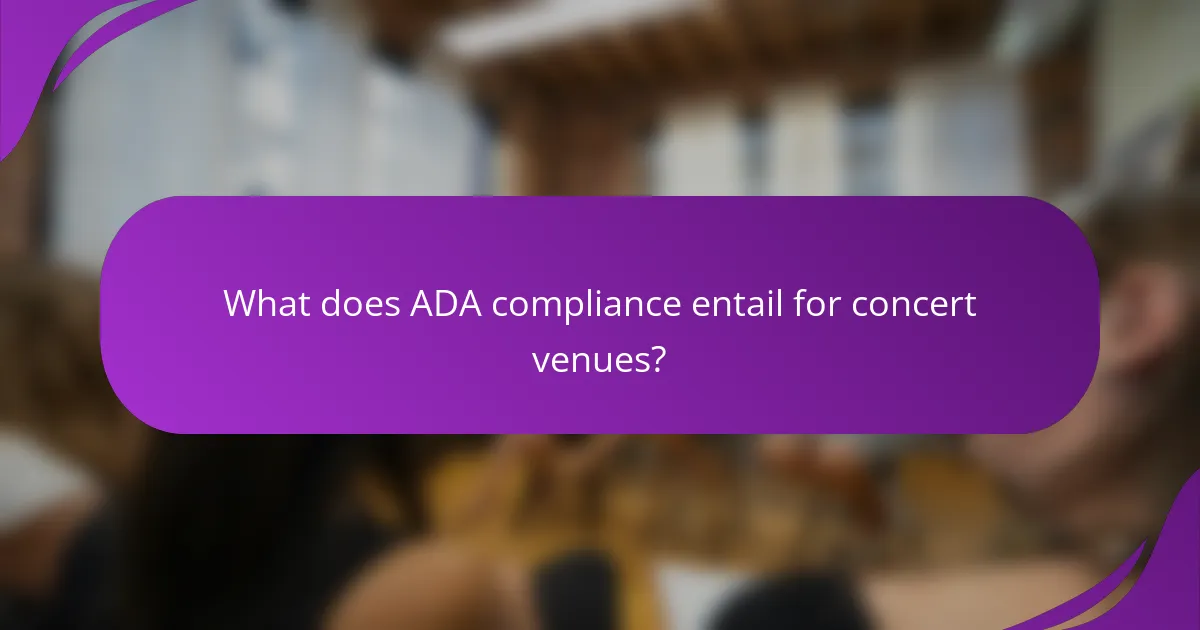
What does ADA compliance entail for concert venues?
ADA compliance for concert venues entails meeting the requirements of the Americans with Disabilities Act. This includes providing accessible seating for individuals with disabilities. Venues must ensure proper wheelchair access throughout the facility. Accessible restrooms must be available and properly equipped. Signage must be clear and visible for navigation. Additionally, emergency evacuation procedures must accommodate individuals with disabilities. Staff training on assisting guests with disabilities is also essential. Compliance helps ensure equal access to entertainment for all individuals.
What are the main ADA guidelines that apply to concert venues?
The main ADA guidelines that apply to concert venues include requirements for accessible seating, parking, and restrooms. Accessible seating must be provided in various locations, allowing for companion seating. Venues must have designated accessible parking spaces near entrances. Restrooms must be accessible and equipped with appropriate grab bars. Additionally, pathways and entrances must be clear and accessible for individuals with disabilities. These guidelines ensure that concert venues accommodate all attendees effectively. Compliance with these guidelines is mandated by the Americans with Disabilities Act.
How do these guidelines affect venue design and layout?
These guidelines significantly influence venue design and layout by prioritizing accessibility for all attendees. Accessible design ensures that individuals with disabilities can navigate the space effectively. This includes features like ramps, wider doorways, and accessible seating areas. Furthermore, the layout must facilitate easy movement between different areas of the venue. Clear signage and designated pathways are essential for guiding attendees. Compliance with ADA standards mandates these features, ensuring legal adherence and enhancing user experience. Studies show that venues with effective accessibility measures attract a broader audience, increasing overall attendance.
What are the consequences of non-compliance with ADA regulations?
Non-compliance with ADA regulations can lead to significant legal and financial consequences. Organizations may face lawsuits from individuals with disabilities who are denied access. These lawsuits can result in costly settlements or judgments. Additionally, the U.S. Department of Justice may impose fines for violations. Businesses may also incur expenses related to required modifications to meet compliance. Non-compliance can damage an organization’s reputation and lead to loss of customers. A study found that businesses that invest in accessibility see increased patronage. Thus, adhering to ADA regulations is crucial for legal protection and business success.
How can venues ensure ongoing ADA compliance?
Venues can ensure ongoing ADA compliance by regularly reviewing and updating their accessibility features. This includes maintaining accessible entrances, restrooms, and seating areas. Staff should receive training on ADA requirements and best practices. Regular audits can help identify areas needing improvement. Venues should also gather feedback from patrons with disabilities. Implementing changes based on this feedback can enhance compliance. Additionally, staying informed about updates to ADA regulations is crucial. Engaging with local disability advocacy groups can provide valuable insights and support.
What regular assessments should venues conduct to maintain compliance?
Venues should conduct regular assessments of their accessibility features to maintain compliance. These assessments include evaluating parking spaces for proper signage and dimensions. Venues must also check the accessibility of pathways and entrances. Regular inspections of restrooms for ADA compliance are essential. Staff training on accessibility protocols should be reviewed periodically. Emergency evacuation procedures must be tested for inclusivity. Feedback from patrons with disabilities should be collected and analyzed. Compliance with local and federal regulations should be regularly updated to reflect current standards.
How can staff training contribute to improved ADA compliance?
Staff training can significantly enhance ADA compliance by equipping employees with knowledge of accessibility standards. Trained staff can identify and address barriers that individuals with disabilities may face. This includes understanding how to assist guests with mobility impairments and ensuring proper use of accessible features. Additionally, training fosters awareness of the importance of inclusive practices. Employees who are informed about ADA regulations are more likely to implement them effectively. Research shows that organizations with trained staff report higher levels of customer satisfaction among individuals with disabilities. This leads to a more welcoming environment and reduces the risk of non-compliance penalties.
What are the best practices for assessing venue accessibility for concerts?
The best practices for assessing venue accessibility for concerts include evaluating physical access, transportation options, and compliance with ADA standards. Start by inspecting entrances and exits for wheelchair accessibility. Ensure pathways are clear and wide enough for mobility devices. Check for accessible seating options and restrooms. Review signage for visibility and clarity. Assess parking facilities for designated accessible spots. Evaluate public transportation routes and their proximity to the venue. Consult with disability advocacy groups for insights. Document findings to ensure accountability and improvement.
How can concertgoers effectively evaluate venue accessibility before attending?
Concertgoers can effectively evaluate venue accessibility by researching the venue’s website and contacting staff directly. Venue websites often provide detailed information on accessibility features. This includes wheelchair access, seating arrangements, and restrooms. Many venues also display their ADA compliance status.
Additionally, concertgoers should read reviews from other attendees regarding their experiences with accessibility. These firsthand accounts can highlight potential issues or confirm positive aspects. Social media platforms can also serve as valuable resources for gathering insights.
Finally, visiting the venue prior to the event, if possible, allows for a firsthand assessment of accessibility features. This proactive approach ensures that concertgoers are well-informed before attending.
What resources are available to assist in assessing venue accessibility?
Resources available to assist in assessing venue accessibility include the ADA National Network and the Access Board. The ADA National Network provides information and guidance on ADA compliance. They offer resources like checklists and training materials for venue assessments. The Access Board develops accessibility guidelines and standards. Their website features tools for evaluating venue features. Local disability advocacy organizations also provide insights and assistance. They can help assess specific venue needs based on community requirements. These resources ensure venues meet accessibility standards for all attendees.
Venue accessibility for concerts encompasses the design and features that allow all individuals, including those with disabilities, to access and enjoy events. Key components include compliance with the Americans with Disabilities Act (ADA), which mandates physical access, transportation options, and adequate parking facilities. This article outlines how to assess venue accessibility by evaluating transportation options, parking considerations, and ADA compliance, emphasizing the importance of inclusivity for all concertgoers. It also highlights best practices for ensuring ongoing compliance and resources available for effective assessment.
